


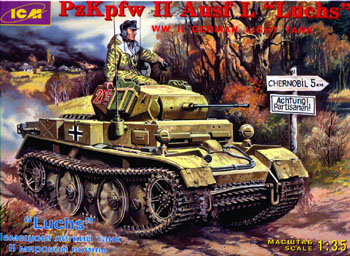 ICM's
1/35TH Pz.Kpw. II Ausf. L "Luchs" (Lynx)
ICM's
1/35TH Pz.Kpw. II Ausf. L "Luchs" (Lynx)
by Ray Mehlberger
MSRP: $22.98
KitLink's Price: $15.98
History
The light tank Pz.Kpw. II Ausf. L 'Luchs' (or Lynx) was the final German effort at light tank production and a logical projection of the Pz.Kpw. II family.
In September, of 1939, the Army Weapons Branch of the Wehrmacht put out a specification for a new general reconnaissance tank. According to the contract, Man was to build the chassis and hull, and Daimler-Benz was to construct the turret. The prototype, which was constructed of mild steel, appeared in mid-1942, under the development number VK 1303 and successfully completed its test trials at the proving ground. Some modifications were made to equip the vehicle for the rough terrain of the Russian front. The tank was equipped with both a long, and a short range wireless radio for communications. Its 20mm automatic main gun, and 7.92mg was to be standard equipment for this German light tank. The crew consisted of four men: tank commander, driver, gunner, and wireless operator.
The engine was powerful and had a low combat weight, which was a positive feature of this tank. The chassis (designed by Kniekampf) had good cross-country capability. This was especially important because of the lack of good road conditions on the Eastern front.
Because its interleaved wheels gave it a certain similarity to the larger Panther tank, the Pz.Kpw. II Ausf. L was given the name of a smaller predator 'Luchs' or 'Lynx'. It also went under the designation of Sd.Kfz. 123.
Production began in 1942 and lasted until 1944, with 133 total vehicle built. 115 of these were assembled by Man and the balance by Henschel.
The Lynx was put into operation with the 3rd, 4th, 5th, and 116th Wehrmacht Tank Divisions (Pz.Div.) and the 3rd S.S. Totenkopf (Death's Head) Div.. The first Lynx went into action on October 25th, 1943 in the Ukraine. On that day, Lynxs commanded by Hauptmann Keisch of the 2nd Company, 4th Tank Reconnaissance Battalion, 4th Tank Division were deployed against partisans in the Kiev area, near Chernobyl. In May 1945, the 4th Tank Division only possessed seven Lynx tanks in any kind of combat condition.
The Lynx was used on the Eastern Front, Italy, Normandy, and in defense of Germany in the final days of the Third Reich. It was well liked by it's crew.
Tech data:
Combat Weight: 11,800kg
Crew: 4
Dimensions: Length 4,630mm, Width 2,480mm, Height
2,210mm
Ground Clearance: 360mm
Armor plate: Hull front 20-30mm, Hull sides 20mm, turret
sides 30mm
Max. Speed: 60km/h
Range: on roads at 60km/h was 200km, cross-country at 42km/h
was 175km
Fuel Capacity: 235 litres
Engine: 4-stroke, 6-cylinder, water-cooled, petrol engine Maybach
HL 66P, developing 200 h.p.
What's in the box?
The kit consists of two light tan trees, two identical light steel colored trees, and one light gray tree.
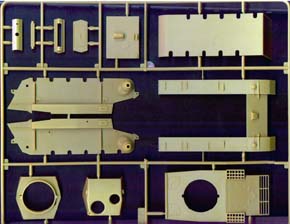 The
first, letter A, light tan plastic tree consists of: the body of the tank.
Parts for this are broken down into the sides, front, rear, and upper
decking. You have to assemble all this into a box. The turret parts are
on this tree also. 12 parts in all here.
The
first, letter A, light tan plastic tree consists of: the body of the tank.
Parts for this are broken down into the sides, front, rear, and upper
decking. You have to assemble all this into a box. The turret parts are
on this tree also. 12 parts in all here.
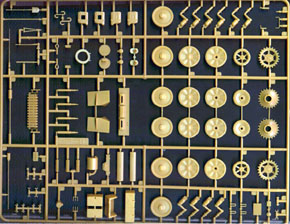 The
second, letter B, light tan tree holds the road wheels, axles, storage
bins, tools, jerry cans etc. 112 total parts on this tree.
The
second, letter B, light tan tree holds the road wheels, axles, storage
bins, tools, jerry cans etc. 112 total parts on this tree.
Two identical letter C, steel colored plastic trees hold the individual track links. There are 104 links per tree, for a grand total of 208 links.
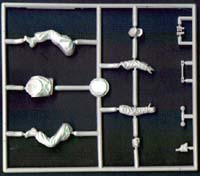 Finally,
one light gray colored tree holds the parts of the tank commander figure.
He is broken down into separate arms, torso, head, a
Finally,
one light gray colored tree holds the parts of the tank commander figure.
He is broken down into separate arms, torso, head, a 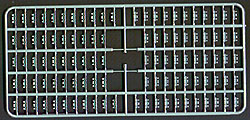 pistol
holster, binoculars, and radio head set. Each of his legs are molded integral
with his hips. He is designed to sit in the upper turret hatch and match
the box art.
pistol
holster, binoculars, and radio head set. Each of his legs are molded integral
with his hips. He is designed to sit in the upper turret hatch and match
the box art.
The instructions are a six page, gatefold affair. Page one of the instructions gives the vehicle's history, in Ukrainian and English. Page 2 is the drawings of the parts trees. Pages 3-4 are the tank and figure's assembly steps. There are 8 assembly steps in all. The most tedious one being the link assembly.
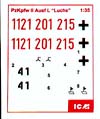 The
last 2 pages of the instructions are devoted to the painting and decaling
drawings. Decals are given for five different paint schemes:
The
last 2 pages of the instructions are devoted to the painting and decaling
drawings. Decals are given for five different paint schemes:
4th Pz.Div. Ukraine, Chernobyl, Oct. 1943
3rd Pz.Div. Western Ukraine, winter 1943-44
4th Pz. Div. Poland, summer 1944
116th Pz. Div. Normandy 1944
3rd S.S. Pz.Div. "Totenkopf", Poland 1944
I have started to build this kit and it will be featured in a later article showing it built. At that time I will tell the readers about the glitches I ran into...which were darn few.
I highly recommend this kit. It is a subject that, for years, I have always said "Why doesn't somebody do....!" My prayers have been answered. I understand that Techmod brand also does a kit of this vehicle in 1/35 too, but have yet to see this kit.
I want to thank Kitlink for providing this review sample.

Previous: Contents








